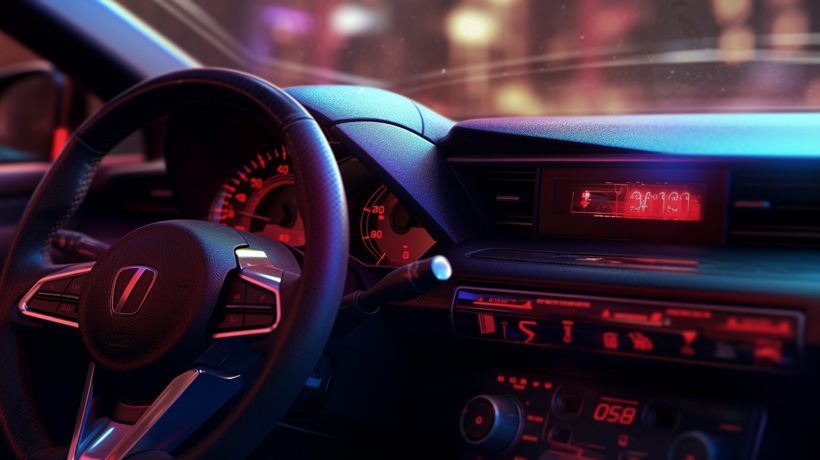Brake Light and ABS Light on and Speedometer Not Working: Causes and Solutions
The brake light, ABS light, and speedometer are essential parts of your vehicle that help you to drive safely. If any of these aren’t working correctly, it can indicate various underlying problems in your vehicle’s braking and sensor systems.
So, why is my brake light and ABS light on and speedometer not working? It can be because of faulty wiring, malfunctioning sensors, or blown fuses. Examine the brake pads, brake fluid level, and ABS sensors to understand the root of the problem. If the problem persists even after restarting your car, consult with a professional!
Encountering the brake light, ABS light, and a non-working speedometer requires a careful and systematic approach. Put safety first, take precautions, and rely on specialists to identify and fix the problems.
1 Minute Quick Overview
Here’s a swift rundown of the common issues and their possible solutions for brake light and ABS light on and speedometer not working in the table below:
| Issues | Solutions |
|---|---|
| Faulty Wheel Speed Sensors | Inspect and replace the sensors |
| Damaged ABS Ring or Tone Wheel | Repair or replace the component |
| Faulty ABS Control Module | Consult with professionals |
| Faulty Vehicle Speed Sensor (VSS) | Replace the sensor |
| Electrical Wiring Issues | Check and repair wiring |
| Corrosion or Dirt Buildup | Clean affected areas |
| Faulty Instrument Cluster | Consult with professionals |
| Low Brake Fluid Level | Check and replenish brake fluid |
Possible Reasons Behind Brake Light and ABS Light on and Speedometer Not Working with Their Solutions
Here are some of the common reasons that cause this issue and how to fix them. While it might be tempting to try and fix the issues yourself, dealing with braking and electrical systems requires expertise. Attempting DIY fixes without proper knowledge could lead to further complications or safety risks.

1. Faulty Wheel Speed Sensors
Wheel speed sensors are crucial for properly functioning the ABS and the speedometer. These sensors monitor the rotational speed of each wheel and provide data to the vehicle’s control modules, like the speedometer.
Solution
To diagnose this issue, follow these steps:
- Lift the vehicle and secure it on jack stands.
- Locate the wheel speed sensors on each wheel hub.
- Check the sensors for damage or corrosion.
- If damaged, replace the sensor with a new one designed for your vehicle model.

Here’s how to replace it:
- Disconnect the wiring harness and remove the sensor using a wrench.
- Install the new sensor and align it properly.
- Reattach the wiring harness.
- Clear any debris or buildup around the sensor.
2. Damaged ABS Ring or Tone Wheel
A damaged ABS ring or tone wheel can result from impacts, corrosion, or wear. It can prevent transmitting accurate wheel speed data to the ABS. Thus, leading to malfunctioning brakes, erratic ABS engagement, and triggering warning lights on the dashboard.
Solution
If the ABS ring is damaged, you may need to:
- Remove the wheel and brake components to access the ABS ring.
- Inspect the ABS ring for cracks, chips, or misalignment.
- Replace the damaged ABS ring with a new one. Here’s how to replace it.
- Lift the vehicle, remove the wheel, and find the ABS ring near the brake components.
- Gently remove the old ring using a hammer and clean the area before installing the new ABS ring.
- Once everything is done, assemble the components and test the vehicle.
3. Faulty ABS Control Module
The ABS (Anti-Lock Braking System) is like an intelligent helper that keeps your wheels from locking up and keeps you in control. It also reduces skidding and prevents potential accidents.
The control module manages the system and communicates with various sensors. A malfunctioning ABS sensor can lead to the erratic behavior of the brake and ABS lights, as well as the speedometer.

Solution
If the ABS control module is suspected to be faulty:
- Consult with a professional mechanic or auto technician.
- They will use specialized diagnostic tools to identify the issue.
- If necessary, they will replace the ABS control module with a new or reprogrammed unit.
ABS ensures that your vehicle’s wheels rotate while braking, maximizing stopping power and reducing the distance required to come to a halt.
4. Faulty Vehicle Speed Sensor (VSS)
Inside the speedometer, there’s a tiny device called a speed sensor. This sensor monitors how fast your car’s wheels are turning.
The VSS provides the speed data needed for the speedometer to display your vehicle’s speed accurately. A malfunctioning VSS can lead to the speedometer not working, causing confusion for the driver.
Diagnosis and Solution
To address a faulty VSS and install a new one:
- Locate the VSS, usually mounted on the transmission or differential.
- Disconnect the wiring harness and remove the VSS.
- Install a new VSS that matches your vehicle’s specifications.
- Carefully screw the new VSS into its mounting point using your fingers to avoid cross-threading.
- Use a wrench or socket set to tighten the VSS securely.
- Reconnect the wiring harness and ensure proper installation.
- Reconnect the negative terminal of the battery and test the VSS.
5. Blown Fuse
A blown fuse can likely cause the warning lights to illuminate and the speedometer to malfunction.
The speedometer is often connected to the vehicle’s electrical system through a dedicated fuse. If this fuse blows, the power supply to the speedometer circuit is disrupted, causing the speedometer to stop functioning.

Solution
Addressing a blown fuse is a relatively straightforward process that can be done with some essential tools and careful attention.
- Refer to your owner’s manual or a fuse box diagram to identify the specific fuse responsible for the brake lights, ABS lights, and speedometer.
- Ensure your vehicle’s ignition is turned off before attempting any maintenance work.
- Using a pair of needle-nose pliers or a fuse puller tool, gently grasp the blown fuse and carefully pull it out from its socket.
- Inspect the blown fuse for any signs of damage, such as a broken filament or discoloration.
- Get a new fuse with the same amperage rating as the blown one.
- Place the new fuse into the empty socket, ensuring it is securely seated.
- With the new fuse in place, turn on your vehicle’s ignition and test the brake lights, ABS, and speedometer.
If the fuse replacement is successful, the warning lights should turn off, and the speedometer should resume normal operation.
6. Electrical Wiring Issues
Frayed, damaged, or corroded wires can disrupt the communication between sensors and control modules, leading to a variety of issues.
Faulty wires can interrupt the electrical connection between the brake pedal switch and the brake lights. Inaccurate signals from damaged wires can lead to erratic ABS functionality.

Solution
To tackle wiring problems:
- Inspect wiring harnesses and connectors for visible damage or corrosion.
- If any issues are found, repair or replace the damaged wires.
- Use appropriate tools and materials, such as crimpers, strippers, and electrical tape, to make secure connections.
- Test the affected components to ensure proper functionality.
7. Corrosion or Dirt Buildup
Corrosion or dirt accumulation on electrical connectors can disrupt the flow of signals between components. They can also obstruct the light output, making the brake lights dimmer and less visible to other drivers.
Thus, the effectiveness and reliability of brake lights and ABS lights can be diminished.
Solution
To remove corrosion and dirt buildup:
- Safely disconnect the affected connectors.
- Use a wire brush or sandpaper to gently clean the contacts.
- Apply dielectric grease to prevent future corrosion (optional).
- Reconnect the connectors securely.
8. Faulty Instrument Cluster
The instrument cluster, which houses the speedometer and warning lights, may experience internal failures that affect its functionality.

Solution
If the instrument cluster is suspected to be faulty:
- Consult with a professional auto technician or mechanic.
- They will diagnose the issue and recommend repair or replacement if necessary.
9. Low Brake Fluid Level
A low brake fluid level can trigger the brake warning light and impact the ABS. This could be due to a leak in the brake system or natural wear and tear.

Solution
To address low brake fluid levels:
- Locate the brake fluid reservoir under the hood.
- Check the brake fluid level against the “MIN” and “MAX” markings on the reservoir.
- Add brake fluid if it’s below the recommended level.
- Ensure the cap is properly secured after adding brake fluid.
10. Worn-out Brake Pads
Worn brake pads can affect the proper functioning of the ABS, leading to warning lights and speedometer problems.

Solution
- Lift the vehicle and remove the wheel.
- Replace the brake pads with new ones to ensure optimal braking performance.
- Test brakes before driving.
After repairs are completed, ask the mechanic to conduct a thorough test, including checking the functionality of the brakes, ABS, and speedometer, before you resume driving.
While the combination of the brake light, ABS light, and a malfunctioning speedometer can be a daunting situation, it’s essential to remember that each vehicle can exhibit unique electrical or signaling issues. For instance, those who frequently haul trailers may encounter problems with the left turn signal and brake light not functioning on their trailers. Similarly, some vehicle owners might notice that the turn signal and brake light aren’t working on one specific side of their car. Grasping these issues’ commonalities can guide you in addressing them more effectively.FAQs
To deal with the stressful situation of the malfunctioning speedometer, ABS light, and brake lights – here are the answers to some common questions:
While driving with these warning lights and a non-working Speedometer is possible, it is not recommended. Your braking performance might be compromised, and you won’t have accurate speed information.
No, the ABS might not function optimally with the light on.
Yes, a malfunctioning ABS sensor can potentially cause the speedometer not to work correctly. Modern vehicles often use the data from the ABS sensors to calculate the vehicle’s speed.
The Bottom Line
Brake lights and ABS lights ensure effective communication, stability, and control during braking. The speedometer helps you maintain safe speeds, adhere to traffic regulations, and optimize your vehicle’s performance.
Once you notice your brake light and ABS light on and speedometer not working, examine the brake pads, brake fluid level, and the ABS sensor for any faults. Fix the blown fuses or broken wiring if there are any. If the issues remain after restarting the car, call a professional as soon as you can!

